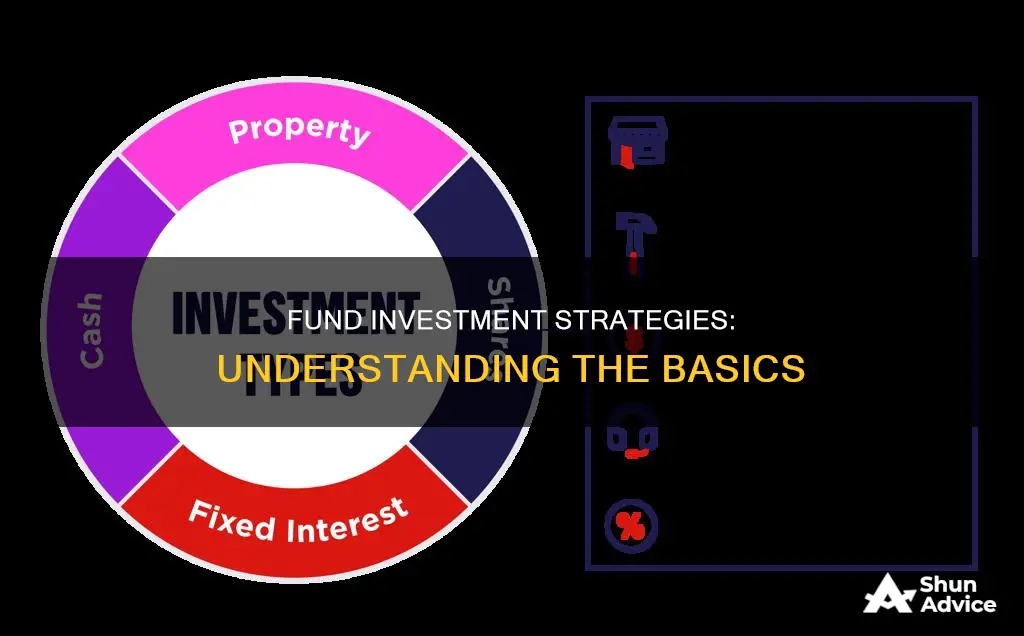
An investment strategy is a set of principles, rules, or procedures that guide an investor's selection of an investment portfolio. It is designed to help an individual investor achieve their financial and investment goals. Investment strategies vary from investor to investor, with the overall target being to align the strategy with the investor's goals, activity, interests, and risk appetite.
There are several types of investment strategies, including passive and active strategies. Passive strategies, such as buy-and-hold and passive indexing, aim to minimize transaction costs, while active strategies, such as momentum trading, attempt to outperform benchmark indexes.
When choosing an investment strategy, it is important to consider factors such as financial situation, risk tolerance, investment goals, and time horizon.
| Characteristics | Values |
|---|---|
| Purpose | Achieve financial and investment goals |
| Risk | Depends on the investor's risk tolerance |
| Returns | Higher risk = higher returns |
| Investor profile | Age, income, investment horizon, financial goals, risk tolerance |
| Investment types | Stocks, bonds, real estate, money market funds, asset allocation |
| Active vs. passive | Active strategies attempt to outperform benchmark indexes, passive strategies minimise transaction costs |
| Diversification | Reduces risk, increases returns |
| Time horizon | Influences the investment strategy |
| Inflation | Investments are chosen to hedge against inflation |
What You'll Learn

Conservative vs aggressive investment strategies
An investment strategy is a set of principles that guides an investor's decisions, helping them achieve their financial and investment goals. These strategies are tailored to an investor's needs, goals, risk appetite, interests, and time horizon.
Conservative and aggressive investment strategies are two ends of the investment spectrum. A conservative investment strategy prioritises the preservation of capital and current income over growth or market returns. It seeks to protect an investment portfolio's value by investing in lower-risk securities, such as blue-chip stocks, fixed-income securities, money markets, and cash or cash equivalents. Conservative investors have a low to moderate risk tolerance and tend to have a shorter time horizon, such as those nearing retirement age. Their portfolios will typically include a higher weighting of low-risk securities, with more than half of their portfolio held in debt securities and cash equivalents rather than equities or other risky assets. While this strategy may protect against inflation, it may not earn significant returns over time compared to more aggressive strategies.
On the other hand, an aggressive investment strategy is ideal for someone who is starting early and wants to build their wealth over time. Aggressive investors have a high-risk tolerance and are focused on growth. They are willing to endure market fluctuations, confident that what goes down will eventually go up, leading to new gains. An aggressive portfolio will typically include newer or less proven companies or industries, which have the potential for large gains but also commensurate losses. This type of portfolio requires a longer time horizon to accommodate potential dips and give the investments time to recover.
It is important to note that investment strategies are not static and should be reviewed periodically as circumstances change. An individual's goals, interests, risk tolerance, and time horizon will influence their choice between a conservative or aggressive investment strategy.
Marijuana Index Funds: A Guide to Investing in Cannabis
You may want to see also

Passive vs active strategies
An investment strategy is a set of principles designed to help an individual investor achieve their financial and investment goals. Investment strategies are not one-size-fits-all, and they vary depending on the investor's personal circumstances, including age, capital, risk tolerance, and goals.
There are two main types of investment strategies: active and passive. Active investing involves buying and selling investments based on their short-term performance, with the goal of beating the average market returns. Active investors take a hands-on approach and rely on a portfolio manager to analyse investments and decide when to buy or sell. Active investing is more expensive due to the need to pay for research analysts and portfolio managers, as well as higher transaction costs.
On the other hand, passive investing involves buying and holding investments with minimal portfolio turnover. Passive investors rarely buy individual investments and instead prefer to hold investments over a long period or purchase shares of mutual or exchange-traded funds. Passive investing generally results in lower buying and selling activity and is a more cost-effective strategy. Passive funds simply follow a market index and have lower fees because less oversight is required.
Both active and passive investing strategies have their advantages and disadvantages. Active investing offers more flexibility, the ability to hedge bets, and the potential for higher returns. However, it is also more expensive and carries the risk of underperforming the market. Passive investing, on the other hand, offers lower fees, good transparency, and tax efficiency. However, passive investing may result in smaller returns and relies on the performance of the underlying index.
Ultimately, the choice between active and passive investing depends on the investor's personal circumstances, goals, and risk tolerance. Many investment advisors recommend blending the two strategies to take advantage of the strengths of both.
Bond Funds vs. ETFs: Where Should You Invest?
You may want to see also

Risk and return trade-offs
Conservative investment strategies tend to involve safe investments with low risks and stable returns. Examples include investing in US Treasury bonds, bills and certificates of deposit (CDs). However, these investments generally provide low returns and may not offer much growth once inflation and taxes are considered.
On the other hand, aggressive investment strategies involve risky investments such as stocks, options and junk bonds, with the goal of generating maximum returns. While these strategies carry the potential for higher returns, they also come with a greater risk of loss.
It's important to note that an investor's risk tolerance plays a significant role in determining their investment strategy. Factors such as age, income and investment horizon influence an investor's risk tolerance. Younger investors, for instance, may have a higher risk tolerance as they have more time to recover from potential losses.
Additionally, investment strategies should be periodically reviewed and adjusted as circumstances change. This is particularly important when it comes to risk and return trade-offs. As an investor's personal situation evolves, their risk tolerance may change, and their investment strategy should be updated accordingly.
Furthermore, diversification is a key risk management technique in portfolio management. By creating a diversified portfolio with different investments across various sectors and asset classes, investors can aim for higher returns while minimising risk. This approach helps to mitigate unsystematic risk, which is associated with individual companies or sectors.
In summary, when considering risk and return trade-offs, investors must carefully assess their risk tolerance, investment goals and time horizon. Diversification and periodic reevaluation of the investment strategy are also crucial to balancing risk and return effectively.
Axis Quant Fund: A Smart Investment Strategy
You may want to see also

Long-term vs short-term goals
When crafting an investment strategy, it is crucial to consider your financial goals and the timeframe within which you aim to achieve them. This distinction often boils down to long-term versus short-term goals, and it plays a pivotal role in shaping your investment journey.
Long-term goals typically refer to financial milestones or objectives that you wish to accomplish over a period of several years or even decades. Common long-term financial goals include saving for retirement, funding a child's education, or accumulating wealth for significant future purchases, such as buying a house. With long-term goals, you usually have a longer time horizon, allowing your investments to grow and compound over time, potentially riding out any short-term market volatility. This extended timeframe also means you can generally afford to take on more risk, as you have the luxury of time to recover from any market downturns.
On the other hand, short-term goals are those that you want to achieve in the near future, typically within the next few months or years. Examples of short-term financial goals include saving for a down payment on a car, planning for a wedding, or building an emergency fund. When investing for short-term goals, your primary focus is often on capital preservation rather than aggressive growth. You want to ensure that the money is readily accessible when you need it, which may mean investing in more conservative, stable options with lower volatility.
Now, let's delve into some specific considerations for each timeframe:
For long-term goals:
- You can generally allocate a larger portion of your portfolio to riskier assets, such as stocks or equity funds. Over longer periods, these tend to provide higher returns, albeit with more ups and downs along the way.
- Diversification is key. Spread your investments across different asset classes, sectors, and geographic regions to mitigate risk and capture a broader range of opportunities for growth.
- Regularly review and rebalance your portfolio to ensure it stays aligned with your long-term goals and risk tolerance. This may involve buying or selling certain assets to maintain your desired allocation.
- Take advantage of compound interest and the power of time by reinvesting any dividends or distributions you receive. This can accelerate your wealth accumulation over time.
For short-term goals:
- Focus on capital preservation and liquidity. Consider investments with lower volatility, such as short-term bond funds, money market accounts, or high-yield savings accounts.
- While returns may be more modest, the trade-off is that your principal is generally safer, and you can access your funds quickly when needed.
- Be mindful of fees, as these can eat into your returns, especially over shorter periods. Look for investment options with low expense ratios and minimal transaction fees.
- Short-term goals may also be an opportunity to explore more conservative investment strategies, such as dollar-cost averaging, where you invest a fixed amount regularly, smoothing out market fluctuations.
In conclusion, a well-rounded investment strategy often involves a combination of long-term and short-term goals. By understanding the unique considerations for each timeframe, you can make more informed decisions about allocating your capital and designing an investment plan tailored to your specific objectives and risk tolerance.
A Guide to Investing in BDO Mutual Funds
You may want to see also

Diversification
Spread the Wealth
It is important not to put all your eggs in one basket. Equities offer the potential for high returns, but it is risky to put all your money in one stock, one sector, or even one market. Consider investing in a range of companies you know and trust and even use in your daily life. You can also invest in commodities, exchange-traded funds (ETFs), and real estate investment trusts (REITs). Think globally to spread your risk and potentially reap bigger rewards.
Consider Index or Bond Funds
Adding index funds or fixed-income funds to your portfolio is a great way to diversify. These funds track various indexes and offer long-term diversification. Fixed-income funds, in particular, can help hedge your portfolio against market volatility and uncertainty. Index funds often have low fees, which puts more money back in your pocket. However, their passively managed nature might be a drawback in inefficient markets.
Keep Building Your Portfolio
Regularly add to your investments using dollar-cost averaging. This strategy smooths out the peaks and valleys created by market volatility by investing the same amount of money over time. As a result, you buy more shares when prices are low and fewer when prices are high.
Know When to Get Out
While buying and holding, and dollar-cost averaging are sound strategies, it is important to stay informed about your investments and the overall market conditions. This way, you will know when it is time to cut your losses, sell, and move on to your next investment.
Keep an Eye on Commissions
Understand the fees you are paying, whether monthly or transactional. Be aware of any changes to your fees, and remember that cheaper is not always better.
Determine Correlation
Even if you own many different investments, your portfolio is not appropriately diversified if they all trend up or down together. For example, high-yield bonds often have a positive correlation with stocks, so a portfolio made of these is not well-diversified.
Diversify Across Asset Classes
There are several primary asset classes to choose from, including fixed-income investments (bonds), cash and cash equivalents, and real assets (property and commodities). A good diversification strategy will contain at least two asset classes.
Diversify Within Asset Classes
You can achieve greater diversification within asset classes by investing in different industries, looking for bonds with different maturities and issuers, and choosing between index funds and funds that focus on specific market segments.
Diversify by Location
Consider global exposure as part of your diversification strategy. For instance, if you only own US securities, your portfolio is subject to US-specific risk. Foreign stocks and bonds can increase diversification but are subject to country-specific risks, such as foreign taxation and currency risks.
Explore Alternative Investments
You can further diversify your portfolio by investing in REITs (which own and operate properties), commodity investments (physical goods like gold or natural gas), and reinsurance (a pooled fund that provides coverage for other insurers).
Rebalance Your Portfolio Regularly
Even a well-diversified portfolio requires periodic rebalancing. Over time, certain investments will gain value, while others will decline. Rebalancing helps your portfolio stay on track by negotiating between risk and reward.
Consider Your Risk Tolerance
Your views on investment risk will impact your diversification strategy. Generally, the longer your investment timeframe, the more risk you can take, and the higher your allocation of stocks can be. Aggressive investors with time horizons of 30 or more years may allocate 90% of their money to stocks and 10% to bonds. On the other hand, conservative investors with low-risk tolerance may opt for a 50/50 balance.
Remember, diversification does not guarantee returns or protect against losses, but it can help mitigate some risks.
Best Index Funds for Investing in India
You may want to see also
Frequently asked questions
An investment strategy is a set of rules, behaviours or procedures that guide an investor's selection of an investment portfolio.
There are three basic investing style types: conservative, moderate, and aggressive. A conservative investor has low to moderate risk tolerance and wants to protect their principal and earn income. A moderate investor is willing to take more risk to achieve stock price appreciation and reasonable but stable income and capital growth. An aggressive investor wants to achieve high overall returns and is willing to take risks.
An investment strategy helps investors make better and more informed decisions about the types of investments they include in their portfolio. It also allows investors to tailor their investment choices to their specific goals, interests, and risk appetite.
It's important to consider your financial situation, risk tolerance, and investment goals when choosing an investment strategy. You should also assess your time horizon, or how long you plan to invest for.
Some common investment strategies include passive index investing, value investing, growth investing, momentum investing, and dollar-cost averaging.







